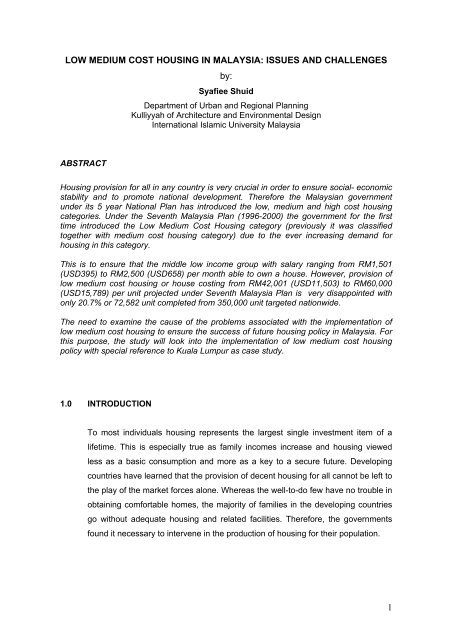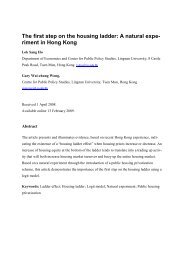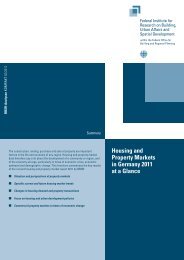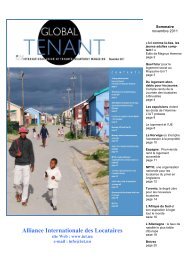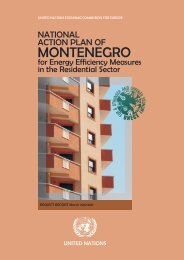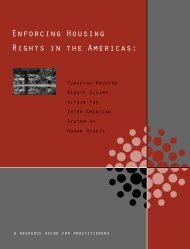1 LOW MEDIUM COST HOUSING IN MALAYSIA: ISSUES AND ...
1 LOW MEDIUM COST HOUSING IN MALAYSIA: ISSUES AND ...
1 LOW MEDIUM COST HOUSING IN MALAYSIA: ISSUES AND ...
Create successful ePaper yourself
Turn your PDF publications into a flip-book with our unique Google optimized e-Paper software.
<strong>LOW</strong> <strong>MEDIUM</strong> <strong>COST</strong> <strong>HOUS<strong>IN</strong>G</strong> <strong>IN</strong> <strong>MALAYSIA</strong>: <strong>ISSUES</strong> <strong>AND</strong> CHALLENGES<br />
by:<br />
Syafiee Shuid<br />
Department of Urban and Regional Planning<br />
Kulliyyah of Architecture and Environmental Design<br />
International Islamic University Malaysia<br />
ABSTRACT<br />
Housing provision for all in any country is very crucial in order to ensure social- economic<br />
stability and to promote national development. Therefore the Malaysian government<br />
under its 5 year National Plan has introduced the low, medium and high cost housing<br />
categories. Under the Seventh Malaysia Plan (1996-2000) the government for the first<br />
time introduced the Low Medium Cost Housing category (previously it was classified<br />
together with medium cost housing category) due to the ever increasing demand for<br />
housing in this category.<br />
This is to ensure that the middle low income group with salary ranging from RM1,501<br />
(USD395) to RM2,500 (USD658) per month able to own a house. However, provision of<br />
low medium cost housing or house costing from RM42,001 (USD11,503) to RM60,000<br />
(USD15,789) per unit projected under Seventh Malaysia Plan is very disappointed with<br />
only 20.7% or 72,582 unit completed from 350,000 unit targeted nationwide.<br />
The need to examine the cause of the problems associated with the implementation of<br />
low medium cost housing to ensure the success of future housing policy in Malaysia. For<br />
this purpose, the study will look into the implementation of low medium cost housing<br />
policy with special reference to Kuala Lumpur as case study.<br />
1.0 <strong>IN</strong>TRODUCTION<br />
To most individuals housing represents the largest single investment item of a<br />
lifetime. This is especially true as family incomes increase and housing viewed<br />
less as a basic consumption and more as a key to a secure future. Developing<br />
countries have learned that the provision of decent housing for all cannot be left to<br />
the play of the market forces alone. Whereas the well-to-do few have no trouble in<br />
obtaining comfortable homes, the majority of families in the developing countries<br />
go without adequate housing and related facilities. Therefore, the governments<br />
found it necessary to intervene in the production of housing for their population.<br />
1
Under the Seventh Malaysia Plan (1996-2000) and Eight Malaysia Plan (2001-<br />
2005), Malaysian government are committed to provide adequate, affordable and<br />
quality housing for all Malaysian, particularly the low income group. This is in line<br />
with Istanbul Declaration on Human Settlement and Habitat Agenda (1996) to<br />
ensure adequate shelter for all.<br />
The government also included for the first time low medium cost housing category<br />
in the Seventh Malaysia Plan for the medium low income group with salary ranged<br />
between RM1,501 to RM2,500 per month with target of 350,000 units are to be<br />
built during the plan period. Unfortunately only 72,582 units or 20.7% from the<br />
target units were built nationwide at the end of the Seventh Malaysia Plan. This<br />
paper will discuss the general scenario of housing in Malaysia particularly the low<br />
medium cost housing.<br />
2.0 OVERVIEW OF <strong>MALAYSIA</strong> <strong>HOUS<strong>IN</strong>G</strong> POLICY<br />
Since independent, the provision of low cost housing has become a priority of the<br />
government in the Five Years National Plans. Government agencies ware directly<br />
responsible in providing housing for the poor in urban areas through<br />
establishment of the State Economic Development Corporations and various<br />
urban development agencies. A Ceiling price for low cost housing was fixed at<br />
RM25,000 per unit for people with household income of less than RM750 per<br />
month since 1982.<br />
In order to ensure the private sector to construct low cost housing, government<br />
through the local authority also impose 30% quota provision of low cost housing in<br />
every residential development. In ensuring that these houses are secured by<br />
targeted group, the government also imposed an open registration system (refer<br />
to Table 1). There are no specific quota or registered purchaser required for other<br />
housing categories.<br />
2
Table 1 : Summary of Malaysia Housing Policy<br />
Phase Period Focus of Attention Strategies Key Documents Policy Analysis<br />
Colonial Period Before - Housing for government staff - Construction of government quarters - Briggs Plan, 1952 - Government are the key<br />
1957 quarters based on department requirement - Land Resettlement Act, 1956 player in housing provision<br />
- Resettlement of people during - Building of houses in the new - Housing Trust Ordinance, 1949 - Physical oriented<br />
communist insurgencies to the settlements with facilities for more than - G. Rudduck Report, 1950's - Ad-hoc policies<br />
new village. 500,000 people.<br />
- Resettlement of people to Felda - Planning and development of Felda<br />
scheme Scheme with the housing and facilities.<br />
- Provision of housing especially for - Setting-up of Housing Trust in 1952.<br />
low income people in urban areas.<br />
Early stage of 1957 - 1970 - Continuing the colonial government - Implementation follow the colonial - First and Second Malaya Plan - Government as key player<br />
Independence policies with minor improvement. policies with limited budget. (1955 - 1964) in housing provision<br />
- Emphasis on housing especially for - Housing Trust involved actively - First Malaysia Plan especially low cost.<br />
low income group in urban areas. low cost housing development in (1965 - 1969) - Private sector to focus<br />
- Private sector involvement in urban areas such as KL and Penang. on medium and high cost<br />
housing provision. - Private sector to concentrate on housing.<br />
- Improvement of basic infrastructure. medium and high cost housing.<br />
New Economic Policy 1971 - 1990 - Eradication of poverty & restructure - High rate of rural-urban migration - New Economic Policy, 1971 - Private sector as key<br />
the society. - Private sector was responsible to built - Second Malaysia Plan to player in housing<br />
- Implementation of Human Settlement large portion of housing for people Fifth Malaysia Plan (1971-1990) provision including<br />
Concept in housing development including low cost. low cost.<br />
- Housing for low income group was - Ceiling price for low cost house was<br />
given priority in national policies. set at RM25,000 in 1982.<br />
- Private sector play as key player - Government established state agencies<br />
in housing provision. - Encourage national unity in housing<br />
development.<br />
Cont’ed<br />
Phase Period Focus of Attention Strategies Key Documents Policy Analysis<br />
3
National 1991 - 2000 - Continue implementation of NEP - To build more affordable housing - National Development Plan, - Private sector still play as<br />
Development Plan policies and strategies. especially low and low medium cost 1991 key player in housing<br />
- Human Settlement Concept with housing. - Sixth and Seventh Malaysia provision but government<br />
Emphasis on sustainable - Low medium cost housing as major Plan (1991 - 2000) created many new laws<br />
development. component in housing provision since - Agenda 21 (UNCHS), 1994 and guidelines to ensure<br />
- To ensure all people regardless of Seventh Malaysia Plan (1996-2000) - The Habitat Agenda 1996 quality housing.<br />
their income to live in decent house. - Emphasis on squatters elimination by<br />
- Private sector continue to responsible the year 2005<br />
in housing provision for the people. - Government created new laws and<br />
guidelines to control private sector<br />
Vison Development 2001 - 2010 - Emphasis on sustainable urban - Continue effort to provide the guidelines - Vision Development Plan - Government as key player<br />
Plan development and adequate housing and inculcate the citizen understanding 2001 in provision of low cost<br />
for all income group. towards sustainable development and - Eight Malaysia Plan, housing provision.<br />
- Housing development will be integ- encourage citizen to participate in 2001 - 2005<br />
rate with other type of development housing development in line with Local<br />
such as industry and commercial. Agenda 21.<br />
- Emphasis on ICT. - Encourage more private developers<br />
- Government as key player in low to construct low medium cost house.<br />
cost housing provision and private - Setting-up Human Settlement Research<br />
sector for medium and high cost Institute or MAHSURI to encourage<br />
housing. research and development in housing.<br />
Source : Various Five Years Malaysia National Plan<br />
4
3.0 <strong>HOUS<strong>IN</strong>G</strong> PRICE CATEGORIES <strong>IN</strong> <strong>MALAYSIA</strong><br />
The housing price categories in Malaysia based on the Ministry of Housing and Local<br />
Government definition can be divided into four categories as listed in Table 2. The<br />
price structure has remained until government announced a new revised price for low<br />
cost housing on 10 th June 1998 as follows:-<br />
Table 2 : House Price Structure and Target Groups<br />
Category<br />
Before June 98<br />
House Price<br />
Per Unit<br />
Target Groups/<br />
Income per month<br />
Low Cost<br />
Low Medium Cost<br />
Medium Cost<br />
High Cost<br />
Below RM 25,000<br />
RM25,001 – RM60,000<br />
RM60,001 – RM100,000<br />
More than RM100,001<br />
Below RM750<br />
RM750 –RM1,500<br />
RM1,501 – RM2,500<br />
More than RM2,501<br />
After June 98<br />
Low Cost<br />
Low Medium Cost<br />
Medium Cost<br />
High Cost<br />
Below RM 42,000<br />
(Depend on Location)<br />
RM42,001 – RM60,000<br />
RM60,001 – RM100,000<br />
More than RM100,001<br />
Below RM1,500<br />
(Depend on house type)<br />
RM1,501 –RM2,500<br />
Not Stated<br />
Not Stated<br />
Source : Ministry of Housing and Local Government Malaysia, 1998<br />
4.0 <strong>LOW</strong> <strong>MEDIUM</strong> <strong>COST</strong> <strong>HOUS<strong>IN</strong>G</strong> <strong>IN</strong> <strong>MALAYSIA</strong><br />
The government has been focused more on low medium cost housing during the<br />
Seventh Malaysia Plan with total 350,000 units or 44% from the total 800,000 units<br />
planned (refer to Table 3).<br />
5
Table 3 : Planned and Completed Housing Unit According to House Price<br />
Category During Sixth and Seventh Malaysia Plan<br />
Sixth Malaysia Plan (91 - 95) Seventh Malaysia Plan (96 - 2000)<br />
Planned Completed % Planned Completed %<br />
PUBLIC SECTOR<br />
Hardcore Poor Housing - - - 35,000 17,229 42.9<br />
Low Cost 126,800 46,497 36.7 60,000 60,999 101.7<br />
Low Medium Cost - - - 110,000 18,782 17.1<br />
Medium Cost 44,600 35,195 78.9 20,000 21,748 108.7<br />
High Cost 2,600 2,850 109.6 5,000 2,866 57.3<br />
Sub Total 174,000 84,542 48.6 230,000 121,624 52.9<br />
PRIVATE SECTOR<br />
Low Cost 217,000 214,889 99.0 140,000 129,598 92.6<br />
Low Medium Cost - - - 240,000 53,800 22.4<br />
Medium Cost 155,900 247,241 158.6 110,000 206,208 187.5<br />
High Cost 26,100 100,788 386.2 80,000 348,250 435.3<br />
Sub Total 399,000 562,918 141.1 570,000 737,856 129.4<br />
Total 573,000 647,460 113.0 800,000 859,480 107.4<br />
Source : Eight Malaysia Plan, 2001<br />
Although the number of units planned for low medium cost houses are the highest<br />
compared to other categories, but the achievement relatively low in both sectors.<br />
During the Seventh Malaysia Plan the construction of medium and high cost housing<br />
by private sector has achieved 187% and 435% respectively of the targeted units. This<br />
situation created the oversupply of housing stock for both categories during 1997-2000.<br />
The Asian economic crisis worsened the properties scenario in Malaysia with many<br />
unsold properties including medium and high cost housing.<br />
The construction of low medium cost housing according to the states in Malaysia also<br />
shown the imbalance of distribution with several states not even building a single low<br />
medium cost houses until 1999 including the Federal Territory of Kuala Lumpur. From<br />
the study, in several states the construction of low medium cost housing has only<br />
started after the government announced the new ceiling price structure for low cost<br />
housing to be at RM42,000 per unit. Other factor including the economic crisis which<br />
require the housing developers to concentrate more focus on affordable housing due to<br />
the oversupply of medium and high cost housing (refer to Table 4).<br />
6
Table 4 : Completed Low Medium Cost Housing according to State, 1996-2000<br />
State 1996 1997 1998 1999 2000<br />
Units % Units % Units % Units % Units %<br />
1. Kuala Lumpur - 0.0 - 0.0 - 0.0 962 7.1 2,866 18.2<br />
2. Johor 1,118 13.9 694 24.5 1,032 11.5 892 6.6 - 0.0<br />
3. Kedah 257 3.2 14 0.5 896 10.0 702 5.2 652 4.1<br />
4. Kelantan 681 8.5 111 3.9 241 2.7 139 1.0 1,072 6.8<br />
5. Melaka 829 10.3 59 2.1 1,216 13.6 550 4.1 - 0.0<br />
6. Neg. Sembilan 115 1.4 24 0.8 1,218 13.6 1,285 9.5 1,083 6.9<br />
7. Pahang 175 2.2 555 19.6 24 0.3 244 1.8 - 0.0<br />
8. Perak 1,193 14.9 87 3.1 468 5.2 1,442 10.7 - 0.0<br />
9. Perlis 147 1.8 - 0.0 120 1.3 125 0.9 - 0.0<br />
10. Pulau Pinang 568 7.1 708 25.0 1,642 18.3 4,548 33.7 7,502 47.7<br />
11. Selangor 2,845 35.5 437 15.4 1,120 12.5 2,322 17.2 1,696 10.8<br />
12. Trengganu 89 1.1 142 5.0 816 9.1 84 0.6 - 0.0<br />
13. Sabah - 0.0 - 0.0 162 1.8 200 1.5 252 1.6<br />
14. Sarawak - 0.0 - 0.0 - 0.0 - 0.0 614 3.9<br />
Malaysia 8,017 100.0 2,831 100.0 8,955 100.0 13,495 100.0 15,737 100.0<br />
Source : Ministry of Housing and Local Government Malaysia, 2001<br />
Map 1 : Map of Malaysia<br />
7
5.0 CASE STUDY : FEDERAL TERRITORY OF KUALA LUMPUR<br />
Federal Territory of Kuala Lumpur is the Capital City of Malaysia with a population of<br />
1,423,900 people in the year 2000 (National Population and Housing Cencus, 2000).<br />
Almost 70% of Kuala Lumpur population is in the active workforce group, of which<br />
more than 52% involved in trading and business activities.<br />
The land area of Kuala Lumpur is 24,221.05 ha. with residential land use being the<br />
largest land use component (23%). However, the trend shows a declining in residential<br />
land use as compared to the 1990 and 1995 data. The demand for the more profitable<br />
land use such as commercial is identified to be the reason for conversion of more<br />
residential lands. The household income structure and affordability level in the year<br />
2000 are shown in Table 5.<br />
Table 5 : Household Income and House Affordability in Kuala Lumpur, 2000<br />
Income Category % Affordability for House<br />
(RM)<br />
Less than 499<br />
0.7<br />
500 – 999<br />
7.4<br />
Below<br />
1000 – 1499<br />
11.8<br />
RM42,000<br />
1500 - 1999<br />
12.8<br />
House Category<br />
Low<br />
Cost<br />
2000 - 2499<br />
2500 - 2999<br />
3000 – 3499<br />
3500 - 3999<br />
Total 32.7<br />
11.0<br />
9.5 RM42,001 toRM85,000 Low Medium<br />
Cost<br />
Total 20.5<br />
8.3<br />
6.0 RM85,001 to RM150,000 Medium Cost<br />
4000 - 4999<br />
More than 5000<br />
Total 14.3<br />
Total 32.5<br />
Source : Kuala Lumpur City Hall, 2002<br />
9.0<br />
23.5 More than RM150,000 High Cost<br />
Although only 20.5% of Kuala Lumpur population within the range of low medium<br />
income but in reality many of them are still struggling to own a house due to ever<br />
increasing cost of living.<br />
5.1 <strong>HOUS<strong>IN</strong>G</strong> <strong>IN</strong> KUALA LUMPUR<br />
8
Generally the City Hall Kuala Lumpur adopted the house prices structure as<br />
proposed by the Ministry of Housing and Local Government, especially for low<br />
cost housing which is at RM42,000 per unit ceiling price. But for the low<br />
medium cost housing, the price structure is a bit different from what has been<br />
proposed by the Ministry due to higher cost for development in Kuala Lumpur.<br />
The price are ranging between RM42,001 to RM85,000 per unit and targeted<br />
for household with income between RM2,001 to RM2,999 per month.<br />
Based on Draft Kuala Lumpur Structure Plan 2020, currently there are<br />
328,205 units of house (excluding temporary houses) as compared to total<br />
household number of 348,800. It means that, Kuala Lumpur still lacks some<br />
20,595 unit of house if the objective of every family to own a house is to be<br />
achieved.<br />
The present housing stock according to the price category is at 3.5% for low<br />
medium cost housing as compared to percentage of targeted group at 20.5%<br />
within the affordability level associated with this category. There is clear<br />
mismatch between the people affordability and house category available at the<br />
market currently. For low cost housing the number is nearly achieve the target<br />
of 30%.<br />
Table 6 : Existing Housing Stock in Kuala Lumpur, 2000<br />
Price Category Unit %<br />
Low Cost<br />
Low Medium Cost<br />
Medium Cost<br />
High Cost<br />
Temporary House<br />
Others<br />
111,906<br />
14,993<br />
61,345<br />
184,725<br />
40,350<br />
15,489<br />
26.1<br />
3.5<br />
14.3<br />
43.1<br />
9.4<br />
3.6<br />
Total 428,808 100<br />
Source : City Hall Kuala Lumpur, 2003<br />
Achievement of construction of low medium cost housing in Kuala Lumpur<br />
during Seventh Malaysia Plan was also the lowest with only 27.3% compared<br />
to medium (233.7%) and high cost (749.6%). The construction of low medium<br />
cost housing only started in 1998 (refer to Table 7).<br />
9
Table 7 : Target and Achievement Housing Construction According to<br />
Price Category in Kuala Lumpur, 1996-2000<br />
Price Target Achievement %<br />
Category Unit % Unit %<br />
Hard Core Poor Housing<br />
100<br />
0.2<br />
0<br />
0.0<br />
0.0<br />
Low Cost<br />
14,000<br />
33.3<br />
4,329<br />
6.0<br />
30.9<br />
Low Medium Cost<br />
14,000<br />
33.3<br />
3,828<br />
5.3<br />
27.3<br />
Medium Cost<br />
8,000<br />
19.0<br />
18,692<br />
26.0<br />
233.7<br />
High Cost<br />
6,000<br />
14.2<br />
44,962<br />
62.6<br />
749.4<br />
Total 42,100 100 71,811 100<br />
Source : 1) Eight Malaysia Plan, 2001<br />
2) Ministry of Housing and Local Government Malaysia, 2001<br />
6.0 <strong>ISSUES</strong> <strong>AND</strong> CHALLENGES <strong>IN</strong> IMPLEMENT<strong>IN</strong>G <strong>LOW</strong> <strong>MEDIUM</strong> <strong>COST</strong> <strong>HOUS<strong>IN</strong>G</strong><br />
<strong>IN</strong> <strong>MALAYSIA</strong><br />
In order to identify the issues and challenges in implementing low medium cost<br />
housing in Kuala Lumpur, interviews with the officers from City Hall Kuala Lumpur<br />
and housing developers in implementing low medium cost housing have been<br />
conducted. The findings of the study are as follows:-<br />
1. There is clear miss-match between the supply and demand of low medium<br />
cost housing in Malaysia.<br />
2. Private developers are not keen in building low medium cost housing due to<br />
low level profitability and the fact no compulsion has been imposed unlike the<br />
low cost housing. Moreover there is no special incentives given to the private<br />
developers to encourage them to build low medium cost housing.<br />
3. The Draft Kuala Lumpur Structure Plan 2020 does not included low medium<br />
cost housing category in the projection of houses unit to be built by year<br />
2020. Although the emphasis of Structure Plan is to provide more houses in<br />
medium cost range (including low medium cost), specific policies and<br />
projection for low medium cost housing category were not clearly stated.<br />
10
4. There are no specific planning and design guidelines for low medium cost<br />
housing compared to low cost housing. The conditions imposed by local<br />
authorities are different from one project to another. This inconsistencies<br />
creates confusion among the private developers.<br />
5. Housing delivery system for low medium cost housing needs to be more<br />
stringent because there is no control over the purchasers. This category of<br />
house are always becoming choice of the property speculators.<br />
6. Without proper regulation by the local authority, the price of low medium cost<br />
housing in Kuala Lumpur are mostly pegged between RM70,000 to<br />
RM85,000 per unit. From the data collected none of the private housing<br />
developers is offering houses at the price between RM42,000 to RM69,999<br />
per unit.<br />
7. Lack of control and monitoring by the local authority for the construction and<br />
completion of medium and high cost housing compared to low cost housing.<br />
8. The construction of low medium cost housing in Kuala Lumpur during and<br />
many other cities only started after 1998 due to the economic downturn.<br />
7.0 RECOMMENDATIONS<br />
At the federal level, the need for National Housing Policy is very crucial for long<br />
term housing planning for the country. This is in line with government objective to<br />
become developed country by the year 2020. With the comprehensive national<br />
housing policy, the government can control and monitor not only construction of low<br />
medium cost housing but also other categories. Proper strategies and programs can<br />
be outlined since this elements lack in the current policy document.<br />
To ensure the housing developers to build more low medium cost housing, the<br />
incentive given to low cost housing such as tax relief, lower land premium, faster<br />
approval, etc. should be extended to low medium cost housing as well. The<br />
government also should set the appropriate quota of low medium cost housing to be<br />
built by housing developers.<br />
11
6.0 CONCLUSION<br />
In order to achieve government aims to provide adequate and decent housing for all<br />
as stated in Eight Malaysia Plan, something needs to be done especially at the<br />
implementation level. This is because under the Eight Malaysia Plan the government<br />
planned to build another 131,300 units of low medium cost housing nationwide.<br />
Special attention must be given to low medium cost housing since majority of this<br />
country population are in this category. The low achievement of Seventh Malaysia<br />
Plan should not hamper the government effort to provide housing in this category.<br />
The need for National Housing Policy then become more crucial since the<br />
government should provide clear direction for housing development in this country in<br />
order to achieve develop nation status by the year 2020.<br />
REFERENCES<br />
Agency For International Development, (1974), Preparing A National Housing Policy,<br />
Office of Housing Guaranty Program, Washington D.C.<br />
Cagamas Berhad, (1997), Housing The Nation : A Definitive Study, Cagamas Berhad,<br />
Kuala Lumpur<br />
Hairi Abdullah, (1995), Titian Warna : Sejarah Pembangunan dan Perubahan Citra Kuala<br />
Lumpur, Penerbitan Sejarah, Kuala Lumpur<br />
Kuala Lumpur City Hall, (1984), Kuala Lumpur Structure Plan, Dewan Bandaraya Kuala<br />
Lumpur<br />
Kuala Lumpur City Hall, (2002), Draft Kuala Lumpur Structure Plan (Reviewed), Dewan<br />
Bandaraya Kuala Lumpur<br />
Malaysian Government, (1996), Seventh Malaysia Plan, Percetakan Nasional Berhad,<br />
Kuala Lumpur.<br />
Malaysian Government, (2001), Eight Malaysia Plan, Percetakan Nasional Berhad, Kuala<br />
Lumpur.<br />
12
Malaysian Government (Statistical Department), (1980), Population and Housing Cencus<br />
Report 1980, Percetakan Nasional Berhad, Kuala Lumpur<br />
Malaysian Government (Statistical Department), (1991), Population and Housing Cencus<br />
Report 1991, Percetakan Nasional Berhad, Kuala Lumpur<br />
Malaysian Government (Statistical Department), (2000), Population and Housing Cencus<br />
Report 2000, Percetakan Nasional Berhad, Kuala Lumpur<br />
Ministry of Housing and Local Government Malaysia (1996), Buletin Perangkaan<br />
Perumahan 1996, Percetakan Nasional Berhad, Kuala Lumpur.<br />
Ministry of Housing and Local Government Malaysia (1997), Buletin Perangkaan<br />
Perumahan 1997, Percetakan Nasional Berhad, Kuala Lumpur.<br />
Ministry of Housing and Local Government Malaysia (1998), Buletin Perangkaan<br />
Perumahan 1998, Percetakan Nasional Berhad, Kuala Lumpur.<br />
Ministry of Housing and Local Government Malaysia (1999), Buletin Perangkaan<br />
Perumahan 1999, Percetakan Nasional Berhad, Kuala Lumpur.<br />
Ministry of Housing and Local Government Malaysia (2000), Buletin Perangkaan<br />
Perumahan 2000, Percetakan Nasional Berhad, Kuala Lumpur.<br />
Oxford University, (2001), Oxford Advance Learner’s Dictionary, Oxford University Press.<br />
Paul N. Balchin, (1989), Housing Policy : An Introduction, Routledge, London<br />
Razali Agus, (2001), Perumahan Awam Di Malaysia : Dasar dan Amalan, Utusan<br />
Publication and Distribution Sdn Bhd, Kuala Lumpur.<br />
United Nations Centre for Human Settlement, (1996), An Urbanizing World : Global<br />
Report on Human Settlements, Oxford University Press, London.<br />
Wegelin, A. Emiel, (1978), Urban Low Income Housing and Development, Studies In<br />
Development and Planning :Erasmus University Rotterdam, Netherland.<br />
United Nations, (1973), Integration Of Housing Into National Development Plans : A System<br />
Approach, Department of Economic and Social Affair, New York<br />
United Nations, (1976), Housing Policy Guidelines For Developing Countries, Department of<br />
Economic and Social Affair, New York<br />
13


